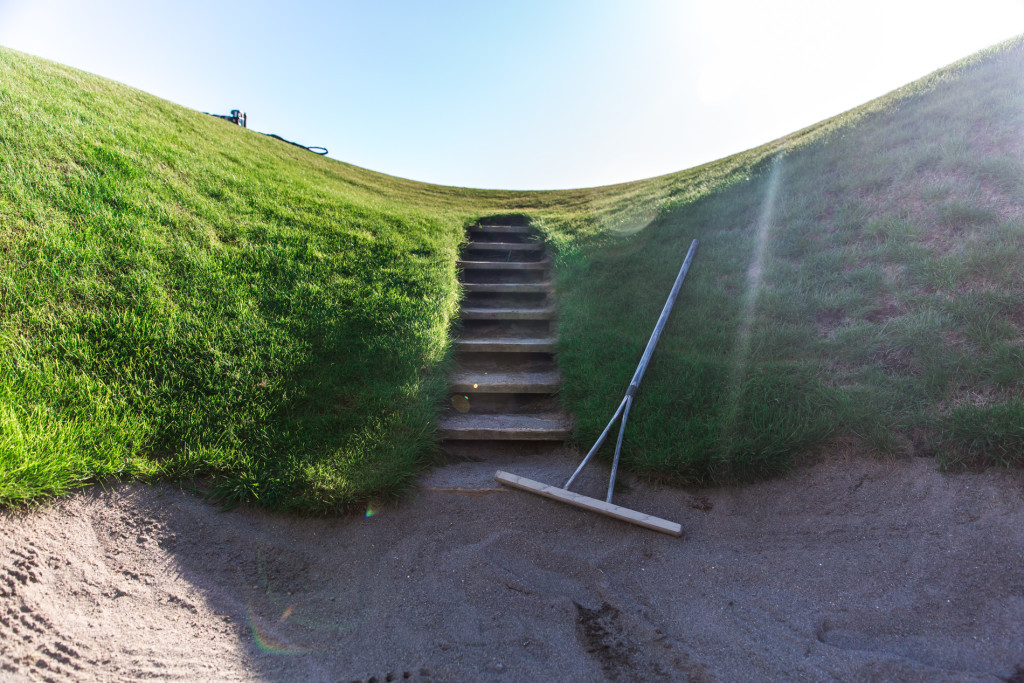2015 U. S. Open Over? Not Yet–Here Anyway. Bring Your Clubs to Play It Again.

This post is about sustainable golf course design with several nods to golfer expectations at Chambers Bay.

“The land set aside for the golf course was degraded after a century of industrial usage but contained bold landforms shaped by wind and weather. Our design team used these landforms as the scaffolding for the golf course design,” states the Robert Trent Jones II website editor.
Note the landscape is not modified by golf cart pathways. You gotta walk it, caddy notwithstanding. Very sustainable in and of itself.
ESPN blared the other day: “Ian Poulter, Billy Horschel rip USGA over green conditions” at U. S. Open golf course Chambers Bay, a former sand/gravel quarry hugging Puget Sound near Takoma, WA.
“I’ve lost some respect for the USGA and this championship this year for the greens,” declared U.S. Open competitor Billy Horschel.
At Chambers Bay six weeks ago, Horschel said he “loved the setting,” comparing it to Pebble Beach and Royal County Down. Now? “It’s just been a disappointing week with the way the greens are.”
“What wasn’t playable were the green surfaces. If this was a regular PGA tour event lots of players would have withdrawn and gone home on Wednesday, but players won’t do that for a major. They were simply the worst most disgraceful surface I have ever seen on any tour in all the years I have played,” fumed Ian Poulter. “The US Open deserves better than that.”
One source of blame, of course, is Robert Trent Jones Jr. who designed the course. He’s the son of legendary British-born golf course designer Robert Trent Jones.
In NPR sports commentator Tom Goldman’s interview with Jones Jr., Goldman ventured: “He appreciates the good shot like any spectator, but truth be told, 75-year-old Robert Trent Jones, Jr. considers himself a competitor with the 156 players in the tournament, and Chambers Bay is his prized weapon.”

“His defenses in this game of designer versus player have names – the mummy mound, the ominous 12-foot deep bunker called Chambers Basement. Despite the competition, Jones wants the course to yield.
Jones’s reply? “But only to great shot-making – thoughtful, creative shot-making, and tactical thinking and courage.”
Replying to Gary Player’s strong words of criticism about the course, Jones said: “First of all, you have to understand that Gary is a competitor in the design business. He was a ruthless competitor in his playing days and at times he can be that way in the design business. We compete for jobs all over the world. I can tell you that I’m open to constructive criticism, but to make it personal is something I can’t understand. What purpose does it serve to find fault with the USGA, with the men who set it up and with the design itself? All I can tell you is that I don’t comment on my competitors. I don’t need to enter a public debate with Gary Player.”
 But, the greens were bumpy and very fast during the Open. They were also slippery. Did you see Tiger loose his footing in the rough the other day?
But, the greens were bumpy and very fast during the Open. They were also slippery. Did you see Tiger loose his footing in the rough the other day?
Should the fine-leaved fescue grass chosen by Jones and used on British golf courses be blamed?
“It grows in a closed-cropped way and therefore tight,” according to Jones. As has oft been observed about the Chambers Bay course, it’s hard to see where the fairways end and the greens begin. That happens in the summer when the drought-resistant fescue changes from a silvery green color to a light brown.
In his competitive proposal to design/buildng Chambers Bay, Jones insisted on fine fescue mixed with colonial bent grass. Golf balls hit hard on it, often bouncing high, skidding and rolling a lot.
Fine-leaved fescue doesn’t need the quantities of water to live that other, more typically used grasses do, including the higher maintenance, invasive species poa annua bluegrass grass commonly seen on West Coast golf courses. It thrives in maritime climates too. When irrigating is needed at the Chambers Bay course, it’s with reclaimed wastewater only. Fertilizer comes in the form of sewage from a nearby waste treatment plant. (Here’s more history and background on the golf course site.)
From the Trent Jones II website: “In an era when global environmental concerns have taken center stage and the golf business is greatly affected by resource issues, the importance of one specific resource stands out: water. Conserving and making the best use of water is essential to the health of the planet and to our great game. All of us in the golf business must work together.”
And: “Our design philosophy further holds that environmental sensitivity and responsibility are essential aspects of every golf course project. At a number of projects in our portfolio, we’ve actually remediated long-term environmental degradation by designing golf courses that repair and improve the environment.” That’s true at Chambers Bay, for one.
The course has been designated an Audubon International Silver Signature Sanctuary. Some think of this designation as the golf course equivalent of LEED certification.
Saving potable water. Walking-only. Challenging course. All good!